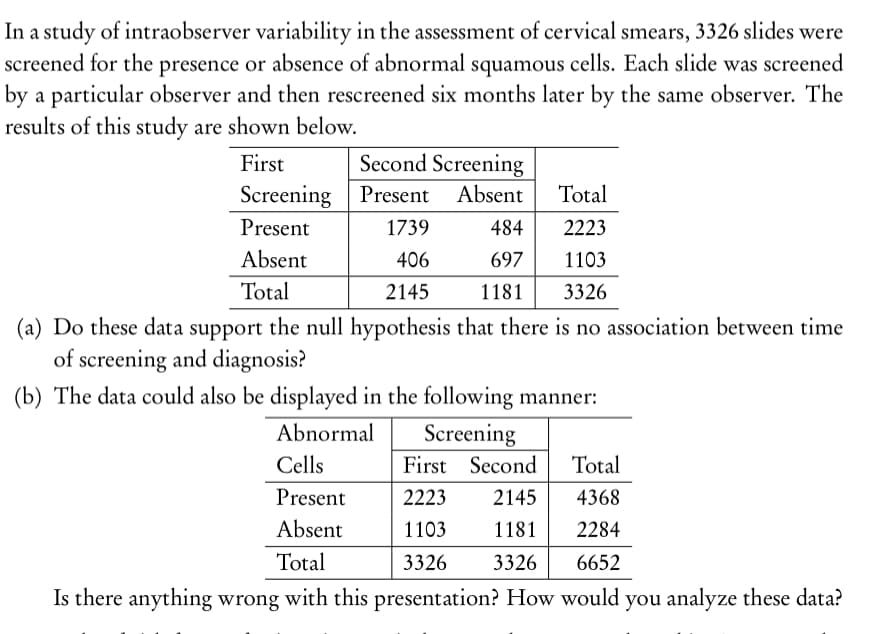In a study of intraobserver variability in the assessment of cervical smears, 3326 slides were screened for the presence or absence of abnormal squamous cells. Each slide was screened by a particular observer and then rescreened six months later by the same observer. The results of this study are shown below. First Second Screening Screening Present Absent Total Present 1739 484 2223 Absent 406 697 1103 Total 2145 1181 3326 (a) Do these data support the null hypothesis that there is no association between time of screening and diagnosis? (b) The data could also be displayed in the following manner: Abnormal Screening First Second Cells Total Present 2223 2145 4368 Absent 1103 1181 2284 Total 3326 3326 6652 Is there anything wrong with this presentation? How would you analyze these data?
In a study of intraobserver variability in the assessment of cervical smears, 3326 slides were screened for the presence or absence of abnormal squamous cells. Each slide was screened by a particular observer and then rescreened six months later by the same observer. The results of this study are shown below. First Second Screening Screening Present Absent Total Present 1739 484 2223 Absent 406 697 1103 Total 2145 1181 3326 (a) Do these data support the null hypothesis that there is no association between time of screening and diagnosis? (b) The data could also be displayed in the following manner: Abnormal Screening First Second Cells Total Present 2223 2145 4368 Absent 1103 1181 2284 Total 3326 3326 6652 Is there anything wrong with this presentation? How would you analyze these data?
Holt Mcdougal Larson Pre-algebra: Student Edition 2012
1st Edition
ISBN:9780547587776
Author:HOLT MCDOUGAL
Publisher:HOLT MCDOUGAL
Chapter11: Data Analysis And Probability
Section: Chapter Questions
Problem 8CR
Related questions
Question

Transcribed Image Text:In a study of intraobserver variability in the assessment of cervical smears, 3326 slides were
screened for the presence or absence of abnormal squamous cells. Each slide was screened
by a particular observer and then rescreened six months later by the same observer. The
results of this study are shown below.
First
Second Screening
Screening Present Absent
Total
Present
1739
484
2223
Absent
406
697
1103
Total
2145
1181
3326
(a) Do these data support the null hypothesis that there is no association between time
of screening and diagnosis?
(b) The data could also be displayed in the following manner:
Abnormal
Screening
First Second
Cells
Total
Present
2223
2145
4368
Absent
1103
1181
2284
Total
3326
3326
6652
Is there anything wrong with this presentation? How would you analyze these data?
Expert Solution
This question has been solved!
Explore an expertly crafted, step-by-step solution for a thorough understanding of key concepts.
This is a popular solution!
Trending now
This is a popular solution!
Step by step
Solved in 3 steps with 3 images

Recommended textbooks for you

Holt Mcdougal Larson Pre-algebra: Student Edition…
Algebra
ISBN:
9780547587776
Author:
HOLT MCDOUGAL
Publisher:
HOLT MCDOUGAL

Holt Mcdougal Larson Pre-algebra: Student Edition…
Algebra
ISBN:
9780547587776
Author:
HOLT MCDOUGAL
Publisher:
HOLT MCDOUGAL